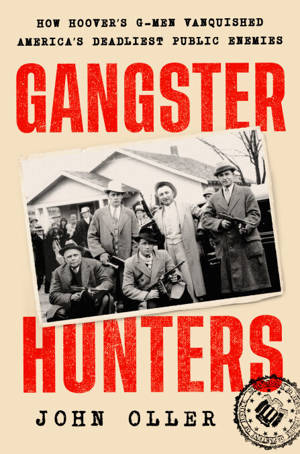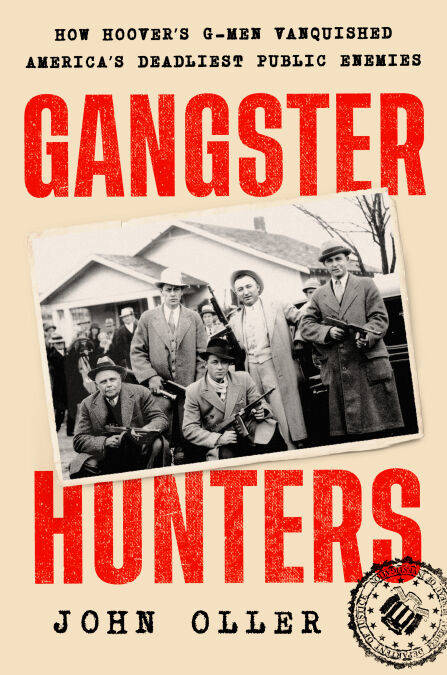
- Afhalen na 1 uur in een winkel met voorraad
- Gratis thuislevering in België vanaf € 30
- Ruim aanbod met 7 miljoen producten
- Afhalen na 1 uur in een winkel met voorraad
- Gratis thuislevering in België vanaf € 30
- Ruim aanbod met 7 miljoen producten
Zoeken
Gangster Hunters E-BOOK
How Hoover's G-men Vanquished America's Deadliest Public Enemies
John Oller
E-book | Engels
€ 22,75
+ 22 punten
Uitvoering
Omschrijving
The enthralling, can't-put-down account of the birth of the modern FBI.
J. Edgar Hoover was the face of the FBI. But the federal agents in the field, relentlessly chasing the most notorious gangsters of the 1930s with their own lives on the line, truly transformed the Bureau.
In 1932, the FBI lacked jurisdiction over murder cases, bank robberies, and kidnappings. Relegated to the sidelines, agents spent their days at their desks. But all of that changed during the War on Crime. Hunting down infamous public enemies in tense, frequently blood-soaked shootouts, the Bureau was thrust onto the front pages for the first time.
Young agents, fresh out of law school and anticipating a quiet, white-collar job, faced off with murderous felons who were heavily armed, clad in bulletproof vests, and owned cars that outraced the best vehicles the Bureau had. But the federal men were fiercely devoted—to the Bureau, to each other, and to bringing America’s most wanted criminals to justice.
The G-men crisscrossed the United States in pursuit of John Dillinger, Bonnie and Clyde, Ma Barker's criminal family, Baby Face Nelson, and Pretty Boy Floyd. But the green FBI agents were always one step behind and a moment too late, the criminals evading elaborate stakeouts and dramatic ambushes. Facing mounting criticism, with bodies left in their wake, the agents had to learn to adapt. After all, more than their reputations were at stake. Through incredible primary source research, John Oller transports readers right to the most harrowing and consequential raids of the 1930s, with fast-paced action that shows the lengths both sides would go to win.
J. Edgar Hoover was the face of the FBI. But the federal agents in the field, relentlessly chasing the most notorious gangsters of the 1930s with their own lives on the line, truly transformed the Bureau.
In 1932, the FBI lacked jurisdiction over murder cases, bank robberies, and kidnappings. Relegated to the sidelines, agents spent their days at their desks. But all of that changed during the War on Crime. Hunting down infamous public enemies in tense, frequently blood-soaked shootouts, the Bureau was thrust onto the front pages for the first time.
Young agents, fresh out of law school and anticipating a quiet, white-collar job, faced off with murderous felons who were heavily armed, clad in bulletproof vests, and owned cars that outraced the best vehicles the Bureau had. But the federal men were fiercely devoted—to the Bureau, to each other, and to bringing America’s most wanted criminals to justice.
The G-men crisscrossed the United States in pursuit of John Dillinger, Bonnie and Clyde, Ma Barker's criminal family, Baby Face Nelson, and Pretty Boy Floyd. But the green FBI agents were always one step behind and a moment too late, the criminals evading elaborate stakeouts and dramatic ambushes. Facing mounting criticism, with bodies left in their wake, the agents had to learn to adapt. After all, more than their reputations were at stake. Through incredible primary source research, John Oller transports readers right to the most harrowing and consequential raids of the 1930s, with fast-paced action that shows the lengths both sides would go to win.
Specificaties
Betrokkenen
- Auteur(s):
- Uitgeverij:
Inhoud
- Aantal bladzijden:
- 512
- Taal:
- Engels
Eigenschappen
- Productcode (EAN):
- 9780593471371
- Verschijningsdatum:
- 25/11/2024
- Uitvoering:
- E-book
- Beveiligd met:
- Adobe DRM
- Formaat:
- ePub

Alleen bij Standaard Boekhandel
+ 22 punten op je klantenkaart van Standaard Boekhandel
Beoordelingen
We publiceren alleen reviews die voldoen aan de voorwaarden voor reviews. Bekijk onze voorwaarden voor reviews.











